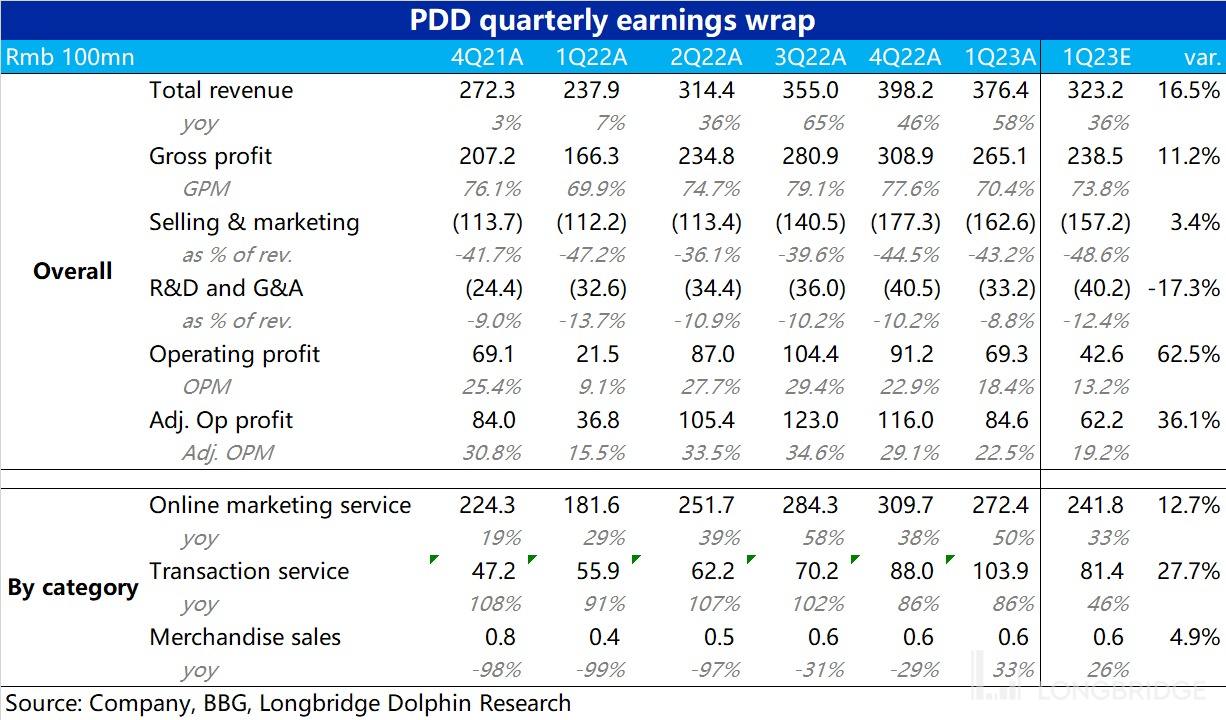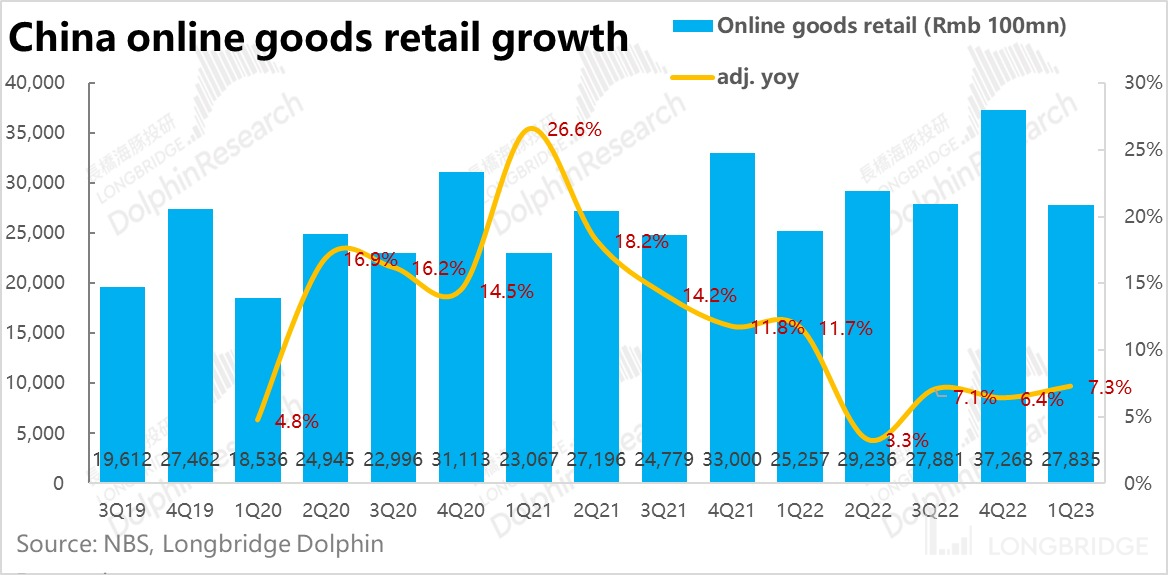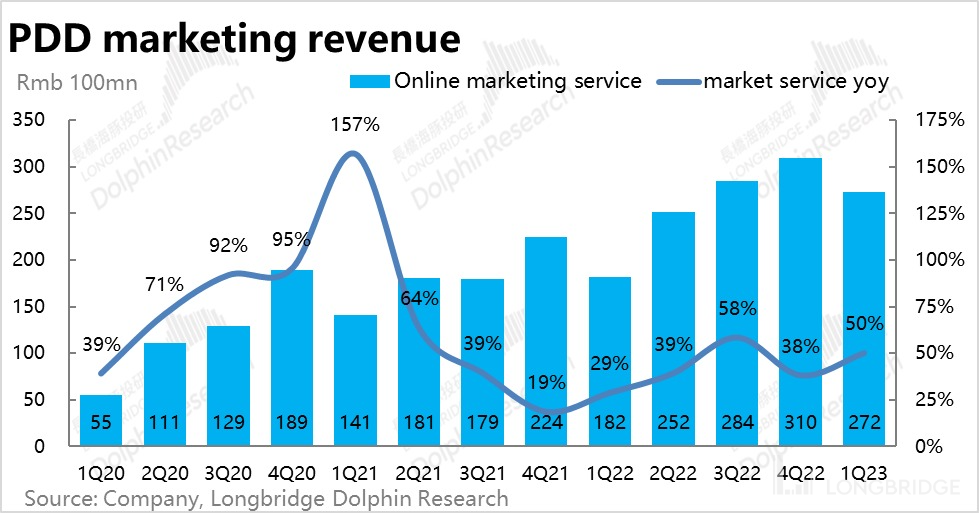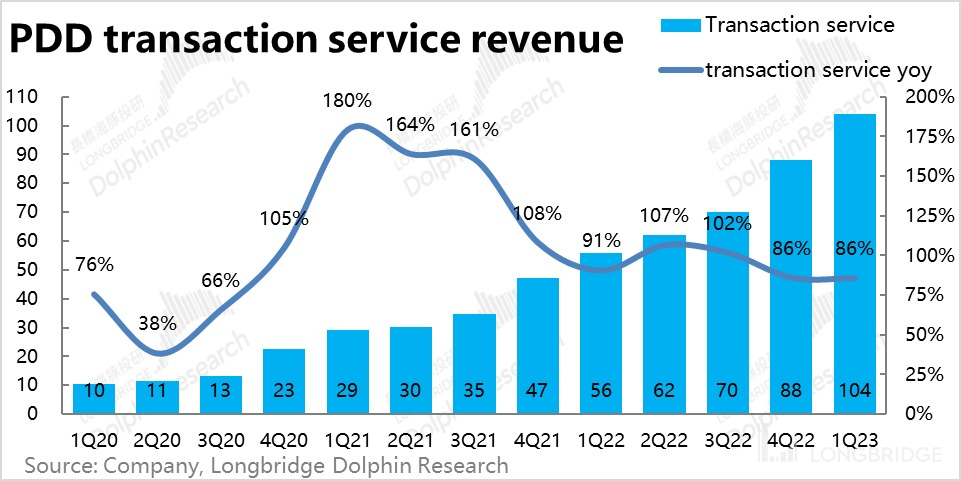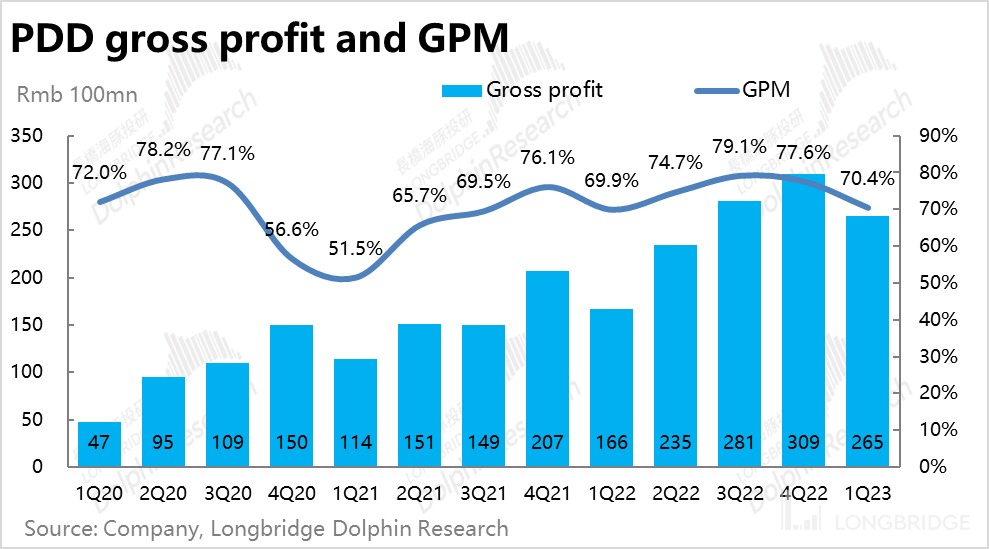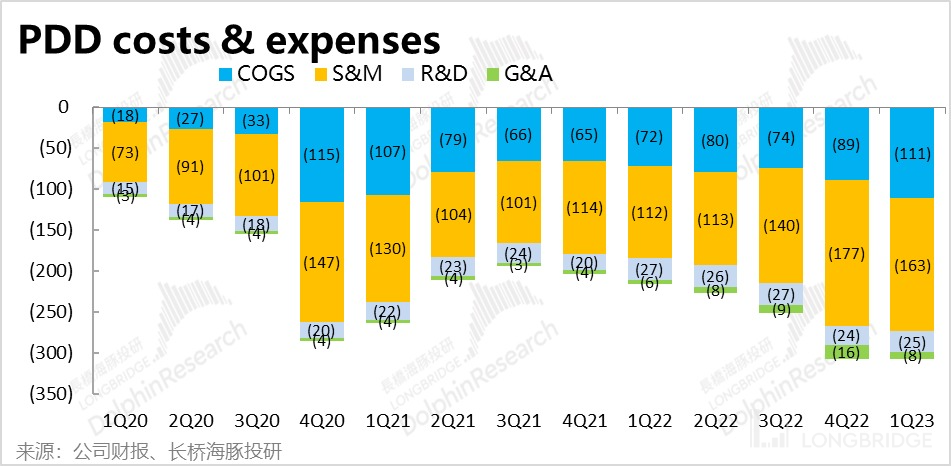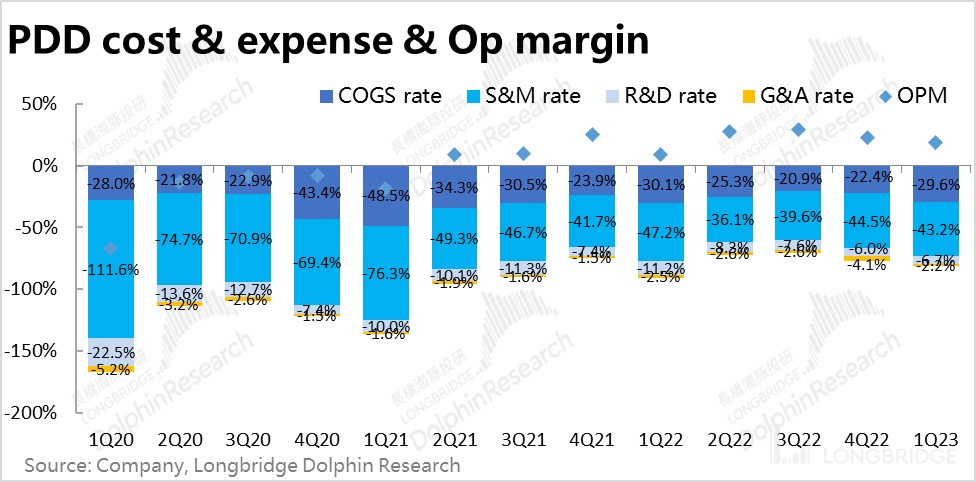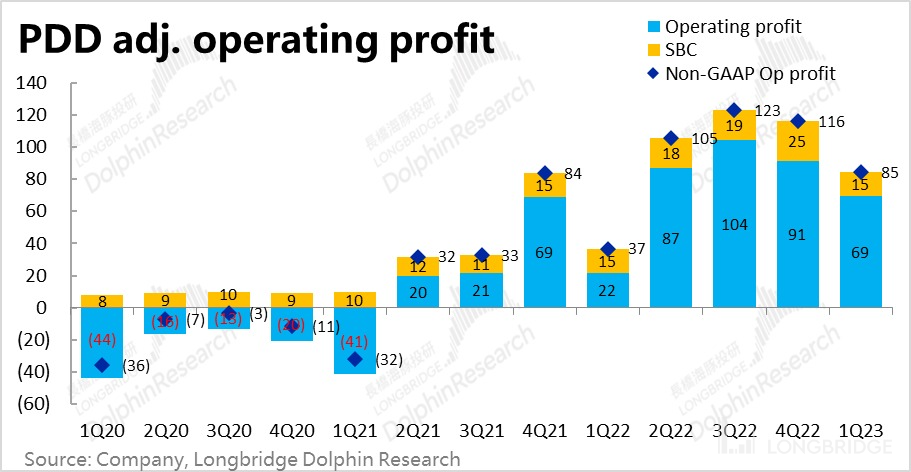
 Likes Received
Likes Received Posts
PostsSlap the short sellers, PDD speaks with strength.

On the evening of May 26th Beijing time, before the US stock market opened, PDD, which had significantly missed its previous quarterly financial report, once again proved its execution ability by delivering a significantly beat performance, with the following key points:
1. Revenue: Expectations were too conservative, PDD proves its strength again
Due to the negative growth of Alibaba and JD.com's e-commerce revenue in the first quarter, and PDD's "miss" in the previous quarter, the market expected PDD's revenue growth rate to slow down from 46% QoQ to 36% QoQ, which was quite conservative given the actual improvement in the growth rate of the domestic online market.
However, in reality, PDD's core e-commerce advertising achieved revenue of RMB 27.2 billion this quarter, with a YoY growth rate of up to 50%, far exceeding the expected RMB 24.2 billion and significantly accelerating compared to the fourth quarter.
At the same time, commission income (including the main site's payment, commission income, and PDD's grocery shopping income, as well as Temu income) achieved revenue of RMB 10.4 billion this quarter, significantly exceeding the market's expected RMB 8.2 billion, with a YoY growth rate maintained at a high level of 86% despite a slight decline in demand for online fresh food retail after the market was opened up domestically. The performance of grocery shopping and Temu should also be impressive.
Therefore, PDD's overall revenue growth this quarter actually reached 58%, far higher than the expected 36% and the previous quarter's 46%.
2. Temu dragged down gross profit, but profits are still considerable
In terms of gross profit, due to revenue far exceeding expectations, although PDD's gross profit margin this quarter fell significantly by 7 percentage points QoQ to 70.4%, which was lower than the market's expected 73.8%, the overall gross profit still reached RMB 26.5 billion, which is higher than the expected RMB 23.8 billion**.
In terms of expenses, the "billion-yuan subsidy" war launched by JD.com and the investment in Temu did not lead to a significant increase in the company's marketing expenses, as the company's marketing expense ratio this quarter was 43.2%, marginally down from 44.5% in the previous quarter and significantly lower than the market's expected expense ratio of 48.6%. It seems that PDD has not felt significant competitive pressure.
As for administrative expenses, after the abnormal inflation caused by a large amount of equity incentives in the previous quarter, it returned to the usual level of single-digit billions this quarter. Therefore, although due to the drag of gross profit margin, PDD's operating profit margin this quarter was only 18.4%, which is significantly lower than the 20%+ level of the past few quarters, the market's profit expectations were too conservative due to the deterioration of competition and the impact of Temu, with only 13.2%. The company's actual performance still far exceeded expectations.
Finally, PDD achieved an operating profit of RMB 6.9 billion this quarter, significantly exceeding the expected RMB 4.26 billion. After adding back the usual level of RMB 1.5 billion in equity incentive expenses, the adjusted operating profit reached RMB 8.5 billion.
 Dolphin Analyst's View:
Dolphin Analyst's View:
Overall, this season PDD has once again delivered a financial report that beats both revenue and profit. And under the standard that revenue beat is the real beat, PDD is also the only one that truly surprises the market in this financial report season except for Beike.
Although PDD's financial report is basically a black box, the key information conveyed this season includes:
1) PDD did not show a significant decline in growth as shown in the fourth quarter financial report. This growth acceleration has shattered the market's concerns about the sustainability of the company's growth. Although the recovery of the domestic online market is weak, PDD's alpha advantage still exists.
2) In terms of competition pattern, although JD and Taotian are vigorously promoting activities such as "billion-yuan subsidies", cost-effective consumption seems to have become the main battlefield of competition. However, from PDD's marketing investment and final profit, the company has not really felt the threat of competition so far.
At the same time, Temu, which is growing rapidly, has not significantly dragged down the company's overall performance, and the company's measures to share costs with merchants are still effective.
Overall, the two core concerns of the market about PDD after the last quarter's financial report have been proved false by the company's answer this time. The company's stock price has also fallen significantly from its high point, corresponding to a PE valuation of less than 20x in 23 years. Therefore, after proving its own strength again and disproving market concerns, it is reasonable for the valuation to be repaired.
Dolphin Analyst has already pointed out the possibility of PDD exceeding expectations in the strategy weekly report at the beginning of this week. Under the situation where the stock price has already fallen reasonably and the current consumption is biased towards deflationary recovery, which is beneficial to platforms with cost-effectiveness like PDD, Dolphin Analyst has reconfigured PDD into the portfolio.
Detailed interpretation of this season's financial report:
1. Expectations are too conservative, and PDD is proving its strength again
Among the three domestic e-commerce giants, Alibaba and JD, which have already announced their performance for the first quarter, still have a very bleak growth rate in their core e-commerce retail income, both of which have negative growth. At the same time, the shadow of PDD's "thunderbolt" in the last quarter still exists, so the market's expectation for the recovery of the e-commerce sector's income is not high.

The market's expected revenue growth rate for PDD in the first quarter is only 36%, which is significantly slower than the 46% growth rate in the fourth quarter. In the case of the improvement of the growth rate of the domestic online market, the expected decline in PDD's growth rate is quite conservative and pessimistic.
However, in fact, the core e-commerce advertising revenue achieved 27.2 billion yuan this season, far exceeding the market's expected 23.2 billion yuan, and the year-on-year growth rate is as high as 50%, which not only far exceeds expectations, but also more importantly, it has accelerated significantly compared with the fourth quarter.
 In addition, the company's commission income (including payment income and commission income from the e-commerce sector, as well as income from PDD's grocery shopping and Temu) reached 10.4 billion yuan this quarter, maintaining a high year-on-year growth rate of 86%, significantly exceeding the market's expectation of 8.2 billion yuan.
In addition, the company's commission income (including payment income and commission income from the e-commerce sector, as well as income from PDD's grocery shopping and Temu) reached 10.4 billion yuan this quarter, maintaining a high year-on-year growth rate of 86%, significantly exceeding the market's expectation of 8.2 billion yuan.
Dolphin Analyst believes that despite a slight decrease in demand for online fresh food retail after the domestic market was opened up, the growth rate of transactional commission income can still remain stable on a month-on-month basis. Although the performance of the three businesses cannot be separated, it can be inferred that the main station, grocery shopping, and Temu businesses are not lagging behind in terms of growth.

Due to the significant growth in advertising and transactional business income, PDD's overall revenue growth this quarter reached 58%, far exceeding market expectations and the 46% growth in the previous quarter. Under the standard that beating revenue is the true beat, PDD is the only company that surprises people in this financial report season, besides Beike.

Second, although the gross profit margin has declined, the profit is still considerable.
Due to the revenue far exceeding expectations, although PDD's gross profit margin this quarter has significantly declined by 7 percentage points to only 70.4%, which is lower than the market's expectation of 73.8%, the final gross profit reached 26.5 billion yuan, still higher than the expected 23.8 billion yuan.

Dolphin Analyst believes that the far-exceeding advertising business growth rate this quarter can basically offset the decrease in monetization rate, which leads to the decline in gross profit margin.
The main reason is still the continuously increasing proportion of transactional income. Since the gross profit margin of the grocery shopping business is at most around 10%, especially Temu's gross profit margin should be even lower, and may even be negative after including performance costs.
According to Dolphin Analyst's rough estimate, Temu's business alone may drag down gross profit by tens of billions of yuan, so the gross profit margin of the main station is probably relatively stable.
At the same time, in terms of expenses, the "billion-yuan subsidy" war launched by JD.com in the first quarter and the investment in Temu did not significantly increase the company's marketing expenses, as the company's marketing expenses this quarter were 16.3 billion yuan, with an expense ratio of 43.2%, a marginal decrease from the 44.5% in the previous quarter (of course, 4Q is the season of the 11 major promotions), and significantly lower than the market's expected expense ratio of 48.6%. So far, it seems that PDD has not felt significant competitive pressure and the drag on Temu's investment has not been as great as expected.
PDD's management expenses returned to the normal level of several hundred million yuan this quarter after abnormally inflating due to large equity incentives in the previous quarter, with a year-on-year increase of only 200 million yuan.
R&D expenses have been stable, with a spending of 2.5 billion yuan this quarter, which is basically flat compared to the same period last year.
Overall, due to the unexpected increase in marketing expenses, the company's overall three expenses amounted to 21.8 billion yuan, which is higher than the market's expected 20.8 billion yuan.
Despite the drag on gross profit margin, PDD's operating profit margin this quarter was only 18.4%, which is significantly lower than the 20%+ level of the past few quarters.
However, due to the deterioration of competition and the impact of Temu, the market's profit expectations were overly conservative, at only 13.2%. Therefore, the company's actual performance still far exceeded expectations.
In the end, PDD achieved an operating profit of 6.9 billion yuan this quarter, significantly exceeding the expected 4.26 billion yuan. After adding back the normal level of 1.5 billion yuan in equity incentive expenses, the adjusted operating profit reached 8.5 billion yuan.
Previous research:
Financial report season
March 20, 2023 conference call "Continuing to invest, PDD insists on shaking things up"
March 20, 2023 financial report review "Inflated ego, is PDD's good days coming to an end?"
November 28, 2022 conference call "Denying three consecutive quarters, PDD claims high profitability is not sustainable (conference call summary)"
November 28, 2022 financial report review "Another explosion in performance, is PDD unstoppable?" On August 29, 2022, Telephone Conference "Future Investment Increase, PDD Firmly Continues to Tinker (Telephone Conference Summary)"
August 29, 2022, Financial Report Review "Performance Explosion! "Roll King" PDD is the King Behind the Scenes"
May 27, 2022, Telephone Conference "R&D Investment Will Increase, Future Profit May Fluctuate (PDD 1Q22 Telephone Conference Summary)"
May 27, 2022, Financial Report Review "Magic Reappears with One Cut, PDD "Kills" Back"
March 21, 2022, Telephone Conference ""Lying Flat Strategy" is Only Temporary, Will PDD Return to Investment & Growth Track? (Telephone Conference Summary)"
March 21, 2022, Financial Report Review "Half Heaven, Half Hell, PDD is "Splitting" Again"
Depth
April 12, 2023, "Fighting for "Cost-effectiveness", When Will Alibaba, JD, and PDD Stop Fighting?"
September 30, 2022, "PDD vs. Vipshop: Your "Poor Days" Are Their "Good Days"?"
April 27, 2022, "Alibaba vs. PDD: After the Bloody Battle, Only Coexistence is Left?"
September 22, 2021, "Alibaba, Meituan, and PDD Went Crazy Killing Each Other. Is There a Real Barrier After the E-commerce Traffic Battle?"
Risk Disclosure and Statement of this Article: Dolphin Research Disclaimer and General Disclosure
The copyright of this article belongs to the original author/organization.
The views expressed herein are solely those of the author and do not reflect the stance of the platform. The content is intended for investment reference purposes only and shall not be considered as investment advice. Please contact us if you have any questions or suggestions regarding the content services provided by the platform.

